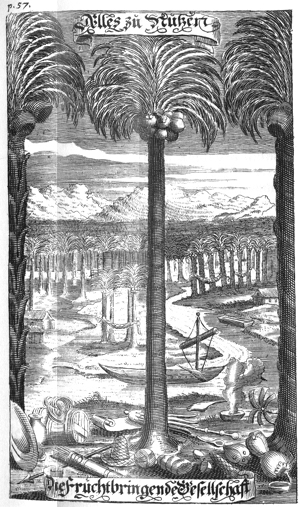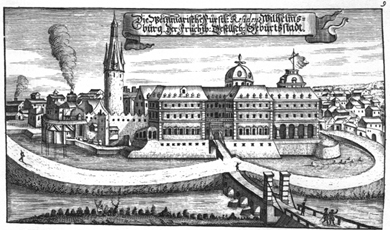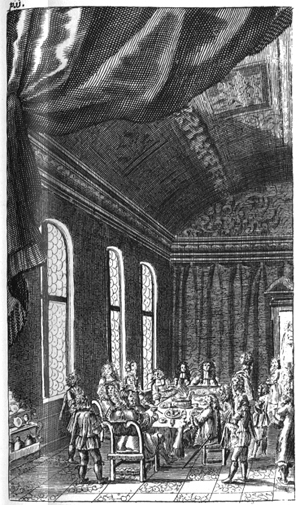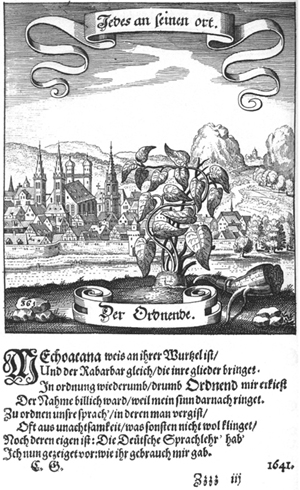The Fruchtbringende Gesellschaft |
Updated: 03/17/2010 | ||||||||||||||
 |
on this page: Foundation of Fruchtbringende Gesellschaft Objectives and regulations of the association The Koethener society book and his function Christian Gueintz and the Fruchtbringenden Gesellschaft Christian Gueintz' entry in the Köthen society book
|
||||||||||||||
Foundation of Fruchtbringende Gesellschaft
 The usage of German language was criticized by the founders, that it became more and more fashion to insert foreign-language expressions in speeches and texts. The following example is given by Neumark: "Monsieur mon tres honore frere, hochgeehrter Herr Patron, Seine hohen meriten / dadurch er mich à l' extreme ihm verobligiret / causiren mich / demselben mit diesen Zeilen zu servieren. Mein Devoir hätte unlängsten mir adresse gegeben / solches zu effectuieren; aber aus manquement einiger occasion, habe ich bis dato mein officium re ipsâ nicht præstieren können. ..." [2] Model were the already since the 15th century existing language societies abroad, in particular the Accademia della Crusca, still existing today, which was founded in 1582 in Florence and where Prince Ludwig of Anhalt was member since July 2st, 1600. [3]
 The Fruchtbringende Gesellschaft was the most important German language association, have had 890 members and existed until 1680. |
 |
||||||||||||||
Objectives and regulations of the associationOne believed that the mother tongue "Uns ganz rein in der ersten Milch / gleichsam eingeträufelt / nachmals aber durch fremdes Wortgepräg / wässerig und versalzen worden". ("Us purely within the first milk / quasi instilled/ but afterwards by strange word stamps / watery and over-salten") It's neccessary to give back again her initial "und angebohren Teutschen Reinlichkeit" ("and inherent German cleanliness") and free it "von fremd-drückenden Sprachjochen" ("from strange language yokes"). [2] The society chose the Indian "palm or coconut palm tree" as a logo why the society was also mentioned "Palmorden" ("Palm order"). It gave themselves as a motto: "Alles zum Nutzen" ("Everything for benefit)". [2] Its companions also received a society-name and a plant as a symbol normally by the head of the society. Above the the symbol - "Gemaehlde" - is placed the motto - "das Wort" - and in a rhyme law - "Reimgesetz" -, the qualities of the plant are explained and referred to possible affinities and traits of the new member. [5] Co-founder and first head of the society, Ludwig Prince of
Anhalt, did bear the society-name "Der Nehrende" ("The
Feeder") and did choose "Nichts bessere" ("nothing
better") as a motto, as well as a symbol "Ein Weitzen-Brodt"
("a wheat bread").  Ludwig Prince of Anhalt died 1650, and 1651 his successor Duke of Saxony-Weimar Wilhelm IV was elected. 1652 he set up the middle class George Neumark as a secretary, included him 1653 into the society, and intoduced him as "Erzschreinhalter" ("owner of the arch shrine"). [3] The communication within the society normally occurred by replacement of letters. Only a few meetings of the members are verified, which took place occasionally in a small circle of 10 to 15 persons. A book, an own work or a work of a colleague was often attached the letter, which the one held for to be recommended. [3] |
|
||||||||||||||
The Koethener society book and his functionThe three-volume society book lies in the historical museum Köthen today. The first volume comes from year 1629 and contains the registration and coats of arms of the first 200 members, the second that of members 201 to 400 and that third that of members 401 to 527. The predecessors of these society books from years 1622, 1624 and 1628 were not so extensive in their structure. [1] For every member, two pages with the following entries were
planned: First page: Coat of arms, name and date of entry. Second
page: Society name, moto and plant. |
|||||||||||||||
Christian Gueintz and the Fruchtbringenden GesellschaftWho Christian Gueinzius proposed to the Fruchtbringende Gesellschaft, is not confessed. He was included 1641 as a 316th companion. As names he received "Der Ordnende" (The Arranger), as a motto "Jedes an seinem Ort" (each on his place) as well as plant and painting the Mechoacana or China root [1]. Ludwig of Saxony-Anhalt wore Christ an Gueinzius already 1619
for conversion of Ratke's reforms to Köthen. His Deutsche
Sprachlehre (Entwurf), Cöthen 164, circulated since
November 1638 for check and improvement among the members of
the Fruchtbingende Gesellschaft and the old employees of Ratkes's
reforms in Koethen as well as among the scholars Buchner and
Schottelius who were included later in the Fruchtbringende Gesellschaft.
In even stronger Die Deutsche Rechtschreibung became a
project of the society - "Auf sonderbares gut befinden
Durch den Ordnenden verfasset Von der Fruchtbringenden Gesellschaft
übersehen und zur nachricht an den tag gegeben measures
(1645)" (Edited by "The Arranger" and not
noticed by the society). Above all the competition attempts of
Schottelius and Harrisdörfer aroused an active discussion
within the Fruchtbringenden Gesellschaft. [1] |
Wolfgang Ratke, latinized Ratich[ius], * Wilster, district Steinburg, October 18th, 1571, + Erfurt, April 27th, 1635, German pedagogue, he presented in1612 to the upper classes of the German empire convened in Frankfurt at M. a "Memorial" about the establishment of a homogeneous German school, in which should taught in "natural" method [8]. August Buchner, * Dresden, November 2nd,1591, + Pollendorf near Wittenberg, February 12th, 1661, professor of oratory at the University of Wittenberg, occupied with the roman language and literature. [1] |
||||||||||||||
|
Christian Gueintz' entry in the Koethen society bookStriking is the absence of every entry of Christian Gueintz
in the Koethener society book of 1646. Halle and Köthen
are not so far from eachother, to enter himself in the society
book would have been possible in spite of disorders of the 30-year
war. [1] Rhyme law:  |
Justus George Schottel(ius), * Einbeck, June 23rd, 1612, + Wolfenbüttel, October 25th, 1676, German grammarian and writer, member of the "Fruchtbringenden Gesellschaft" and the "Nürnberger Dichterkreis" (Nuermberger poet ring). Besides his lesser important lyrical and dramatic poetries famous is his contribution as important scholar, grammarian and poet of the 17th century. He examined the etymology of the German words and would plan a normative grammar and a general dictionary for the consolidation and pure preservation of German language. [7]
George Phillipp Harsdoerf(f)er, * Fischbach near Nuremberg November 1st,1607, + Nuremberg September 17st, 1658, German poet, set up the Nuernberger poet ring togeteher with J. Klaj , ascribed songs as well as small anecdotal stories, in addition a poetics, "Poetischer Trichter ..." (poetic funnel), he searched to support social ways of life by "Gesprächsspiele" (conversation games). [7] Jacob Theodor- Tabernaemontanus, * Bergzabern 1522, + Heidelberg 1590, one the most important Palatinate physician and botanist, Ditter/Diether (Theodor) was borne as bondslave, studied medicine in Padua, Montpellier and Heidelberg, was personal physician of Lord Philip II from Nassau-Saarbrücken and the Bishop of Speyer, known by medicating person suffering on pest and his writings and books, among others "New herbal" (1588). Source: Http://www. Kraeter.ch/taberneamontanus.htm (25.12.2003).  |
||||||||||||||
Sources
|
|